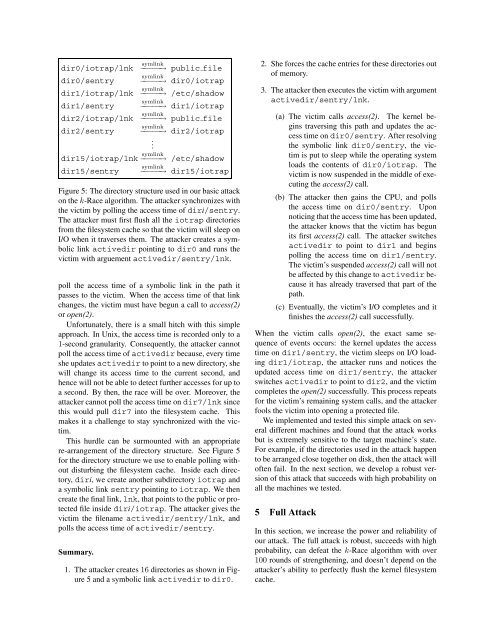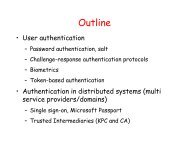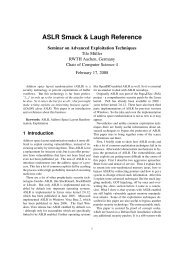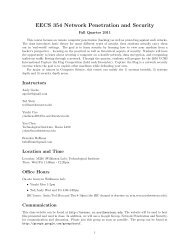Fixing Races for Fun and Profit: How to abuse atime - University of ...
Fixing Races for Fun and Profit: How to abuse atime - University of ...
Fixing Races for Fun and Profit: How to abuse atime - University of ...
Create successful ePaper yourself
Turn your PDF publications into a flip-book with our unique Google optimized e-Paper software.
dir0/iotrap/lnk symlink<br />
−−−−−→ public file<br />
dir0/sentry<br />
symlink<br />
−−−−−→ dir0/iotrap<br />
dir1/iotrap/lnk symlink<br />
−−−−−→ /etc/shadow<br />
dir1/sentry<br />
symlink<br />
−−−−−→ dir1/iotrap<br />
dir2/iotrap/lnk symlink<br />
−−−−−→ public file<br />
dir2/sentry<br />
symlink<br />
−−−−−→ dir2/iotrap<br />
.<br />
dir15/iotrap/lnk symlink<br />
−−−−−→ /etc/shadow<br />
dir15/sentry<br />
symlink<br />
−−−−−→ dir15/iotrap<br />
Figure 5: The direc<strong>to</strong>ry structure used in our basic attack<br />
on the k-Race algorithm. The attacker synchronizes with<br />
the victim by polling the access time <strong>of</strong> diri/sentry.<br />
The attacker must first flush all the iotrap direc<strong>to</strong>ries<br />
from the filesystem cache so that the victim will sleep on<br />
I/O when it traverses them. The attacker creates a symbolic<br />
link activedir pointing <strong>to</strong> dir0 <strong>and</strong> runs the<br />
victim with arguement activedir/sentry/lnk.<br />
poll the access time <strong>of</strong> a symbolic link in the path it<br />
passes <strong>to</strong> the victim. When the access time <strong>of</strong> that link<br />
changes, the victim must have begun a call <strong>to</strong> access(2)<br />
or open(2).<br />
Un<strong>for</strong>tunately, there is a small hitch with this simple<br />
approach. In Unix, the access time is recorded only <strong>to</strong> a<br />
1-second granularity. Consequently, the attacker cannot<br />
poll the access time <strong>of</strong> activedir because, every time<br />
she updates activedir <strong>to</strong> point <strong>to</strong> a new direc<strong>to</strong>ry, she<br />
will change its access time <strong>to</strong> the current second, <strong>and</strong><br />
hence will not be able <strong>to</strong> detect further accesses <strong>for</strong> up <strong>to</strong><br />
a second. By then, the race will be over. Moreover, the<br />
attacker cannot poll the access time on dir7/lnk since<br />
this would pull dir7 in<strong>to</strong> the filesystem cache. This<br />
makes it a challenge <strong>to</strong> stay synchronized with the victim.<br />
This hurdle can be surmounted with an appropriate<br />
re-arrangement <strong>of</strong> the direc<strong>to</strong>ry structure. See Figure 5<br />
<strong>for</strong> the direc<strong>to</strong>ry structure we use <strong>to</strong> enable polling without<br />
disturbing the filesystem cache. Inside each direc<strong>to</strong>ry,<br />
diri, we create another subdirec<strong>to</strong>ry iotrap <strong>and</strong><br />
a symbolic link sentry pointing <strong>to</strong> iotrap. We then<br />
create the final link, lnk, that points <strong>to</strong> the public or protected<br />
file inside diri/iotrap. The attacker gives the<br />
victim the filename activedir/sentry/lnk, <strong>and</strong><br />
polls the access time <strong>of</strong> activedir/sentry.<br />
Summary.<br />
1. The attacker creates 16 direc<strong>to</strong>ries as shown in Figure<br />
5 <strong>and</strong> a symbolic link activedir <strong>to</strong> dir0.<br />
2. She <strong>for</strong>ces the cache entries <strong>for</strong> these direc<strong>to</strong>ries out<br />
<strong>of</strong> memory.<br />
3. The attacker then executes the victim with argument<br />
activedir/sentry/lnk.<br />
(a) The victim calls access(2). The kernel begins<br />
traversing this path <strong>and</strong> updates the access<br />
time on dir0/sentry. After resolving<br />
the symbolic link dir0/sentry, the victim<br />
is put <strong>to</strong> sleep while the operating system<br />
loads the contents <strong>of</strong> dir0/iotrap. The<br />
victim is now suspended in the middle <strong>of</strong> executing<br />
the access(2) call.<br />
(b) The attacker then gains the CPU, <strong>and</strong> polls<br />
the access time on dir0/sentry. Upon<br />
noticing that the access time has been updated,<br />
the attacker knows that the victim has begun<br />
its first access(2) call. The attacker switches<br />
activedir <strong>to</strong> point <strong>to</strong> dir1 <strong>and</strong> begins<br />
polling the access time on dir1/sentry.<br />
The victim’s suspended access(2) call will not<br />
be affected by this change <strong>to</strong> activedir because<br />
it has already traversed that part <strong>of</strong> the<br />
path.<br />
(c) Eventually, the victim’s I/O completes <strong>and</strong> it<br />
finishes the access(2) call successfully.<br />
When the victim calls open(2), the exact same sequence<br />
<strong>of</strong> events occurs: the kernel updates the access<br />
time on dir1/sentry, the victim sleeps on I/O loading<br />
dir1/iotrap, the attacker runs <strong>and</strong> notices the<br />
updated access time on dir1/sentry, the attacker<br />
switches activedir <strong>to</strong> point <strong>to</strong> dir2, <strong>and</strong> the victim<br />
completes the open(2) successfully. This process repeats<br />
<strong>for</strong> the victim’s remaining system calls, <strong>and</strong> the attacker<br />
fools the victim in<strong>to</strong> opening a protected file.<br />
We implemented <strong>and</strong> tested this simple attack on several<br />
different machines <strong>and</strong> found that the attack works<br />
but is extremely sensitive <strong>to</strong> the target machine’s state.<br />
For example, if the direc<strong>to</strong>ries used in the attack happen<br />
<strong>to</strong> be arranged close <strong>to</strong>gether on disk, then the attack will<br />
<strong>of</strong>ten fail. In the next section, we develop a robust version<br />
<strong>of</strong> this attack that succeeds with high probability on<br />
all the machines we tested.<br />
5 Full Attack<br />
In this section, we increase the power <strong>and</strong> reliability <strong>of</strong><br />
our attack. The full attack is robust, succeeds with high<br />
probability, can defeat the k-Race algorithm with over<br />
100 rounds <strong>of</strong> strengthening, <strong>and</strong> doesn’t depend on the<br />
attacker’s ability <strong>to</strong> perfectly flush the kernel filesystem<br />
cache.













